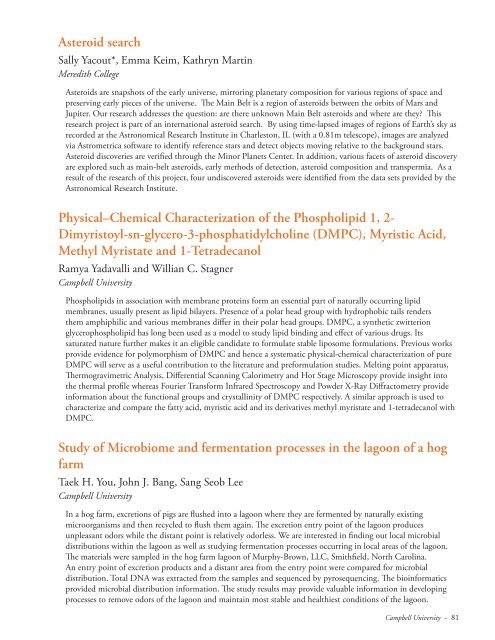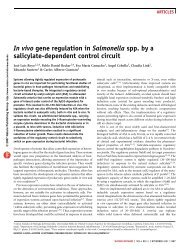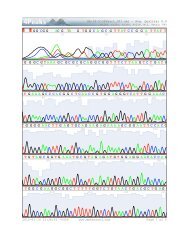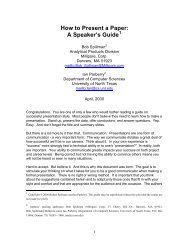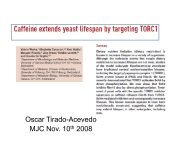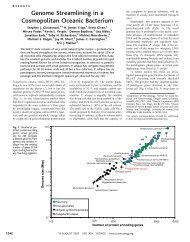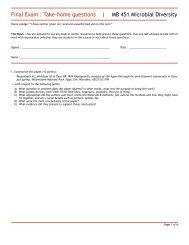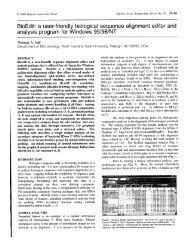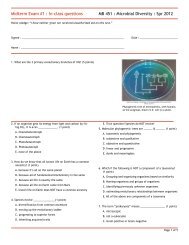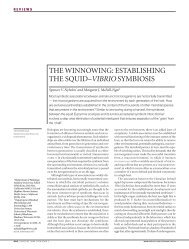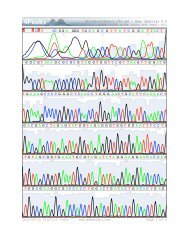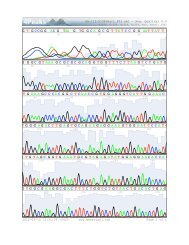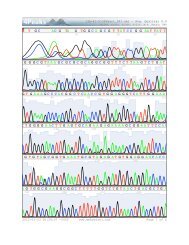Schedule and Program - North Carolina Academy of Science
Schedule and Program - North Carolina Academy of Science
Schedule and Program - North Carolina Academy of Science
You also want an ePaper? Increase the reach of your titles
YUMPU automatically turns print PDFs into web optimized ePapers that Google loves.
Asteroid searchSally Yacout*, Emma Keim, Kathryn MartinMeredith CollegeAsteroids are snapshots <strong>of</strong> the early universe, mirroring planetary composition for various regions <strong>of</strong> space <strong>and</strong>preserving early pieces <strong>of</strong> the universe. The Main Belt is a region <strong>of</strong> asteroids between the orbits <strong>of</strong> Mars <strong>and</strong>Jupiter. Our research addresses the question: are there unknown Main Belt asteroids <strong>and</strong> where are they? Thisresearch project is part <strong>of</strong> an international asteroid search. By using time-lapsed images <strong>of</strong> regions <strong>of</strong> Earth’s sky asrecorded at the Astronomical Research Institute in Charleston, IL (with a 0.81m telescope), images are analyzedvia Astrometrica s<strong>of</strong>tware to identify reference stars <strong>and</strong> detect objects moving relative to the background stars.Asteroid discoveries are verified through the Minor Planets Center. In addition, various facets <strong>of</strong> asteroid discoveryare explored such as main-belt asteroids, early methods <strong>of</strong> detection, asteroid composition <strong>and</strong> transpermia. As aresult <strong>of</strong> the research <strong>of</strong> this project, four undiscovered asteroids were identified from the data sets provided by theAstronomical Research Institute.Physical–Chemical Characterization <strong>of</strong> the Phospholipid 1, 2-Dimyristoyl-sn-glycero-3-phosphatidylcholine (DMPC), Myristic Acid,Methyl Myristate <strong>and</strong> 1-TetradecanolRamya Yadavalli <strong>and</strong> Willian C. StagnerCampbell UniversityPhospholipids in association with membrane proteins form an essential part <strong>of</strong> naturally occurring lipidmembranes, usually present as lipid bilayers. Presence <strong>of</strong> a polar head group with hydrophobic tails rendersthem amphiphilic <strong>and</strong> various membranes differ in their polar head groups. DMPC, a synthetic zwitterionglycerophospholipid has long been used as a model to study lipid binding <strong>and</strong> effect <strong>of</strong> various drugs. Itssaturated nature further makes it an eligible c<strong>and</strong>idate to formulate stable liposome formulations. Previous worksprovide evidence for polymorphism <strong>of</strong> DMPC <strong>and</strong> hence a systematic physical-chemical characterization <strong>of</strong> pureDMPC will serve as a useful contribution to the literature <strong>and</strong> preformulation studies. Melting point apparatus,Thermogravimetric Analysis, Differential Scanning Calorimetry <strong>and</strong> Hot Stage Microscopy provide insight intothe thermal pr<strong>of</strong>ile whereas Fourier Transform Infrared Spectroscopy <strong>and</strong> Powder X-Ray Diffractometry provideinformation about the functional groups <strong>and</strong> crystallinity <strong>of</strong> DMPC respectively. A similar approach is used tocharacterize <strong>and</strong> compare the fatty acid, myristic acid <strong>and</strong> its derivatives methyl myristate <strong>and</strong> 1-tetradecanol withDMPC.Study <strong>of</strong> Microbiome <strong>and</strong> fermentation processes in the lagoon <strong>of</strong> a hogfarmTaek H. You, John J. Bang, Sang Seob LeeCampbell UniversityIn a hog farm, excretions <strong>of</strong> pigs are flushed into a lagoon where they are fermented by naturally existingmicroorganisms <strong>and</strong> then recycled to flush them again. The excretion entry point <strong>of</strong> the lagoon producesunpleasant odors while the distant point is relatively odorless. We are interested in finding out local microbialdistributions within the lagoon as well as studying fermentation processes occurring in local areas <strong>of</strong> the lagoon.The materials were sampled in the hog farm lagoon <strong>of</strong> Murphy-Brown, LLC, Smithfield, <strong>North</strong> <strong>Carolina</strong>.An entry point <strong>of</strong> excretion products <strong>and</strong> a distant area from the entry point were compared for microbialdistribution. Total DNA was extracted from the samples <strong>and</strong> sequenced by pyrosequencing. The bioinformaticsprovided microbial distribution information. The study results may provide valuable information in developingprocesses to remove odors <strong>of</strong> the lagoon <strong>and</strong> maintain most stable <strong>and</strong> healthiest conditions <strong>of</strong> the lagoon.Campbell University - 81


